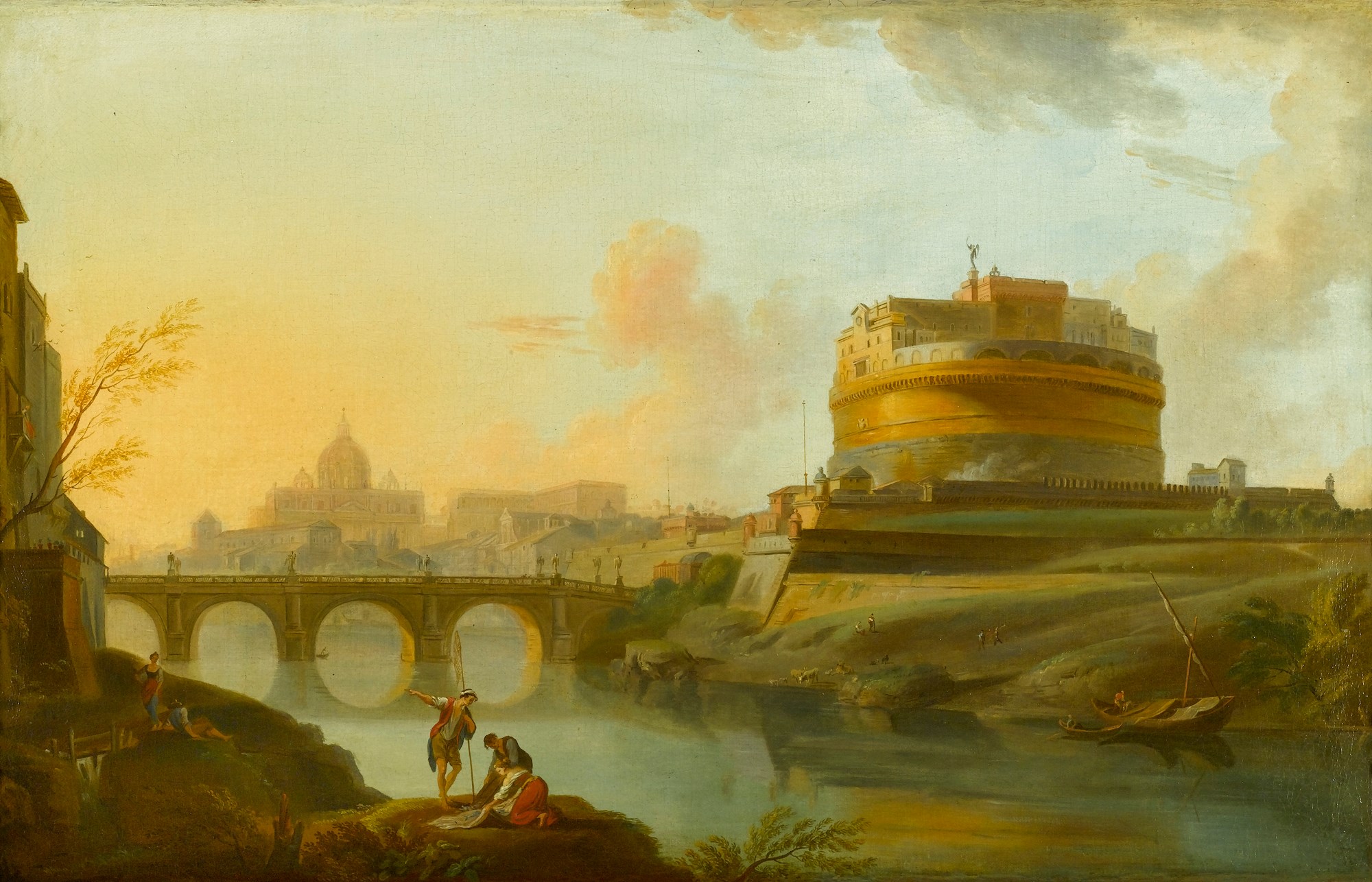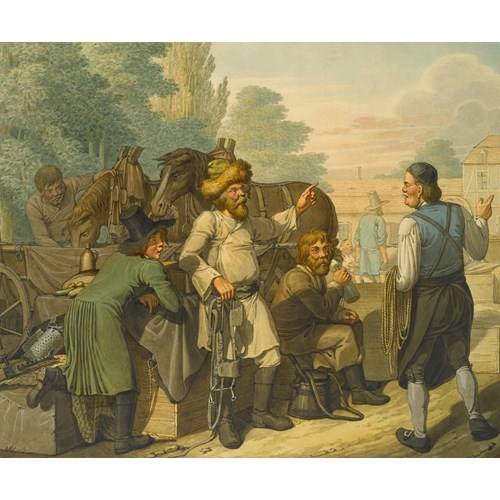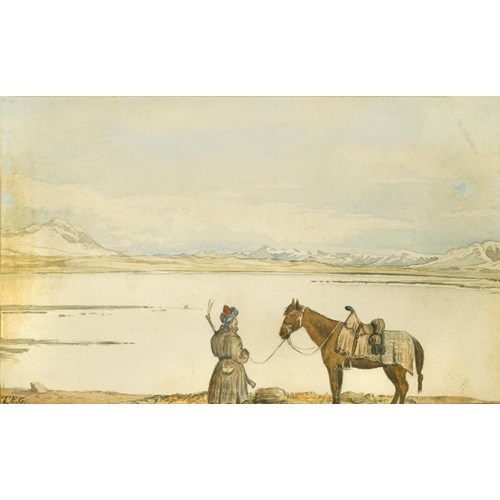Marketplace
View of the Tiber, Rome, with the Castel Sant’Angelo and St. Peter’s beyond
Jean-Baptiste Lallemand
View of the Tiber, Rome, with the Castel Sant’Angelo and St. Peter’s beyond
Period 1750-1850, 18th century
Origin France
Medium Oil on canvas
Dimension 44 x 69.2 cm (17³/₈ x 27¹/₄ inches)
In this beautiful depiction of Rome, a soft dawn light slowly envelops the scene. In the foreground a fisherman is standing over a woman who wraps the daily catch in a sheet, presumably ready for market. Beyond them a couple lazily relax, whilst on the far bank herdsmen watch over their grazing cattle. However, these figures are not the focus of the work, but serve to animate the beautiful historic landscape in which they are set. Spanning the calm expanse of the Tiber is the rhythmic arches of the Ponte Sant’Angelo, which leads the eye to the imposing bulk of the Castel Sant’Angelo. In the background, surrounded by dawn mist, is the Vatican, dominated by the instantly recognisable silhouette of St. Peter’s. Jean-Baptiste Lallemand has created a delightful contrast in this painting, where monumental architectural achievements are viewed through a prism of complete tranquillity and calm, before the start of the hustle and bustle of daily urban life.
The Castel Sant’Angelo is one of the most recognisable buildings in Rome. It was originally erected in the second century by the Emperor Hadrian (76-138 AD), as a mausoleum for himself and his family and the bridge also dates from this time. The building was converted into a military fortress in 401, and a Papal Castle in the beginning of the fourteenth century. It takes its name from a legend that says that the Archangel Michael appeared atop it in 590, sheathing his sword as a sign of the end of the plague. If the citadel is an emblem of the Roman Empire, then St. Peter’s is an outstanding symbol of Papal achievement. There had been a basilica on the site since the fourth century, but having fallen into disrepair, its rebuilding can be seen as one of the architectural high points of the Renaissance. It has been described as ‘the greatest of all churches of Christendom’¹
This vista was clearly a favoured view of Lallemands. In addition to a gouache sketch in Chicago², there is another fractionally larger, but otherwise identical, depicts the Ponte Rotto, the oldest stone bridge in Rome which dates from the second century BC. Again Lallemand is referring to Rome’s historic status, as a city whose primacy and magnificence stretches back to antiquity.
Lallemand was born in Dijon, the son of a tailor, and moved to Paris, becoming a member of the Académie de Saint-Luc in 1745. Two years later he moved to Rome, by which time he was a well-known landscape painter, and he remained there for fourteen years. In Italy he came into contact with some of the leading landscape painters of the day, including Hubert Robert (1733-1808) and Claude-Joseph Vernet (1714-1789), and the latter’s influence in particular is evident in the present work. His time in Rome was characterised by a number of important commissions, but he returned to France in 1761. Here he continued to work as a landscape painter, but also expanded his repertoire to encompass many genres, form History painting to genre scenes inspired by Dutch seventeenth-century artists.³
¹ Fletcher, B., Sir Banister Fletcher’s a History of Architecture, (20th ed. Architectural Press, London, 2001) p.719.
² Smart Museum of Art, University of Chicago, no. 2006.96.
³ For more on the painter’s life and works, see Jean-Baptiste Lallemand. Un Paysagiste dijonnais du Xviii siècle, exh. cat, Museé des Beaux-Arts, Dijon, 1954.
The Castel Sant’Angelo is one of the most recognisable buildings in Rome. It was originally erected in the second century by the Emperor Hadrian (76-138 AD), as a mausoleum for himself and his family and the bridge also dates from this time. The building was converted into a military fortress in 401, and a Papal Castle in the beginning of the fourteenth century. It takes its name from a legend that says that the Archangel Michael appeared atop it in 590, sheathing his sword as a sign of the end of the plague. If the citadel is an emblem of the Roman Empire, then St. Peter’s is an outstanding symbol of Papal achievement. There had been a basilica on the site since the fourth century, but having fallen into disrepair, its rebuilding can be seen as one of the architectural high points of the Renaissance. It has been described as ‘the greatest of all churches of Christendom’¹
This vista was clearly a favoured view of Lallemands. In addition to a gouache sketch in Chicago², there is another fractionally larger, but otherwise identical, depicts the Ponte Rotto, the oldest stone bridge in Rome which dates from the second century BC. Again Lallemand is referring to Rome’s historic status, as a city whose primacy and magnificence stretches back to antiquity.
Lallemand was born in Dijon, the son of a tailor, and moved to Paris, becoming a member of the Académie de Saint-Luc in 1745. Two years later he moved to Rome, by which time he was a well-known landscape painter, and he remained there for fourteen years. In Italy he came into contact with some of the leading landscape painters of the day, including Hubert Robert (1733-1808) and Claude-Joseph Vernet (1714-1789), and the latter’s influence in particular is evident in the present work. His time in Rome was characterised by a number of important commissions, but he returned to France in 1761. Here he continued to work as a landscape painter, but also expanded his repertoire to encompass many genres, form History painting to genre scenes inspired by Dutch seventeenth-century artists.³
¹ Fletcher, B., Sir Banister Fletcher’s a History of Architecture, (20th ed. Architectural Press, London, 2001) p.719.
² Smart Museum of Art, University of Chicago, no. 2006.96.
³ For more on the painter’s life and works, see Jean-Baptiste Lallemand. Un Paysagiste dijonnais du Xviii siècle, exh. cat, Museé des Beaux-Arts, Dijon, 1954.
Period: 1750-1850, 18th century
Origin: France
Medium: Oil on canvas
Dimension: 44 x 69.2 cm (17³/₈ x 27¹/₄ inches)
More artworks from the Gallery









